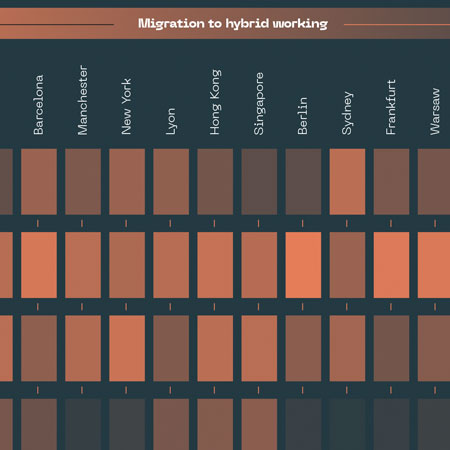Women make up 50% of the global population but less than 40% of the global labour force, according to the World Bank. It has therefore never been more important to understand how to attract and retain female talent, particularly as the so-called ‘Great Resignation’ has led to increased competition for workers.
And as women are often an underutilised resource in the world of work, many firms are leaving potential for growth and profit on the table. There is a commercial relationship between diversity and performance, and share value for businesses and occupiers of office spaces – it is all about talent, the workforce, and designing places for the future.
At an organisational level, it has long been established that a diverse workforce can help drive innovation, creativity, and productivity. A McKinsey report found that a company with diverse staffing outperforms a non-diverse one by 15% (gender diverse) and 35% (ethnically diverse). Beyond increased performance, diverse staffing provides benefits for the ‘Social’ element of many companies ESG strategies.
With diverse staffing comes more diverse needs from offices. The corporate workplace has historically been designed by men and for men. At a basic level, things like temperature and lighting have been based on the male needs. With so many women now entering the labour force, changes to the office are likely.
Thinking ahead to 2022 and beyond, what can businesses learn about the attraction and retention of talent and where in the world are women workers most likely to succeed?
Designing a more inclusive office space
Women play an important role in the world of work – approximately 40% of the global labour force and growing. As nations move up the global wealth ladder, more women will likely enter office-based employment roles, and shaking up the world of work.
Savills conducted a survey of workers and found that there are differences in gender preferences for certain office amenities. Of the 29 items that the Savills Office Fit Survey asked respondents to score out of importance, men and women generally want the same thing from their office spaces. However, there were several key differences along gender lines.
While men prioritised things such as shower facilities, car parking, bicycle storage, and charge points for electric vehicles, women tended to prioritise security, personal safety, the ability to open windows, and recycling options.
Nearly 90% of female respondents ranked personal safety as an important feature to include in office spaces, something which will be key in current and future office spaces as workers return to the office. Furthermore, nearly 75% of women ranked building security as important to their office experiences.
Women and Work
Globally, professional women can face many different environments when interacting with the world of work. At the heart of this issue are several key trends: lack of representation in senior leadership roles – both in business and politics, unequal remuneration, burdens of care, and lack of support for flexible options within the workplace. From education to starting businesses to purchasing assets, women often have starkly different experiences to their male counterparts.
To understand the legal circumstances that professional working women face worldwide, the Savills ‘World of Women and Work’ Index focusses on five key metrics: work and pay equality, business and asset ownership equality, parenting and home life, government representation for women, and educational attainment of women.
Index metrics
Work and Pay: Are women able to work in similar jobs for the same pay as their male counterparts?
Business and Asset ownership: Can women access capital, start businesses, and own assets in the same way as men?
Parenting and home life: Is there paid parental leave for women and men and how much time is spent on unpaid domestic and care work?
Government representation: What is the share of women in upper levels of government?
Education: Do women have high levels of educational attainment?
*Work and Pay is double weighted, Government representation and Education are both half weighted
There’s historically been a strong perception that the Scandinavian countries lead the pack in terms of advancement and equality for women, but our analysis shows that the story is much more pan-European than initially thought. Other countries outside of Europe that perform well include Canada, New Zealand, and Australia.
When examining the top scoring countries in the World of Women and Work Index, it becomes clear that the countries which are doing things right by women, are nearly all doing the same levels of right things. Across the top 20 locations, the difference in index scores between the first and twentieth ranked country is only five points. While there is very little difference between the top ranked countries, each shows different strengths within the index.
It is worth noting that the data analysed for this index details the legal situation for women in different countries, rather than the actual situation on the ground. For many, there can be a disconnect between the legal environment and the lived experience for many women. The fact that there are countries which have the legal infrastructure in place for women shows that immense progress has been made. However, it is very clear, even from the legal rights for women, that there is room for improvement.
When it comes to true work and pay equality, Nordic countries; Sweden, Norway, and Iceland, lead the category. Strict provisions regarding equal pay and high labour force participation rates for women help propel these countries to the top of the league table.
Estonia and Austria come first and second, respectively, in terms of their legal equality for business and asset ownership. Estonia in particular has prioritised its business environment in recent years, going so far as to launch a digital nomad visa and e-residency programmes to boost business growth and attract talent. Globally when women own businesses and have access to capital and assets, they often employ more women and increase outcomes for women overall. This is especially key as fewer than 5% of companies have more than 50% female boards according to BoardEx, presenting ample opportunities for global businesses.
Parenting and home life is most equal in Iceland, Finland, and Bulgaria. Well known for their provisions for parents, the inclusion of two Scandinavian leaders is unsurprising. Notable wildcard Bulgaria performs well because of its provisions for maternity leave (410 days) and shared parental leave (365 days). When women and parents are able to access parental leave programmes, women in particular are more likely to re-enter the workforce after the birth of a child.
When women have a voice and representation in government, the ability and willingness to address issues particular to women, becomes much more commonplace. Leaders for the government representation category include Finland, Iceland, and Austria. Each of these countries has had female heads of state as well as high proportions of women in parliament and ministerial positions.
A highly educated workforce can enable workers to obtain higher paying, professional employment. For women in particular, educational attainment is one of the strongest indicators of projected lifetime earnings. Poland, Bulgaria, and Belgium lead the educational attainment category with high proportions of women completing university education and increased numbers of women completing degrees in business in particular.
Understanding the different priorities and experiences for men and women can only help businesses and occupiers of office space create the best environments for their increasingly diverse workforces. As we witness the emergence and resurgence of a globally transient workforce, we anticipate that talented women will likely choose to move to locations where the environment suits their personal and professional development. Ensuring that inclusive office space is available to accommodate them is important too.



